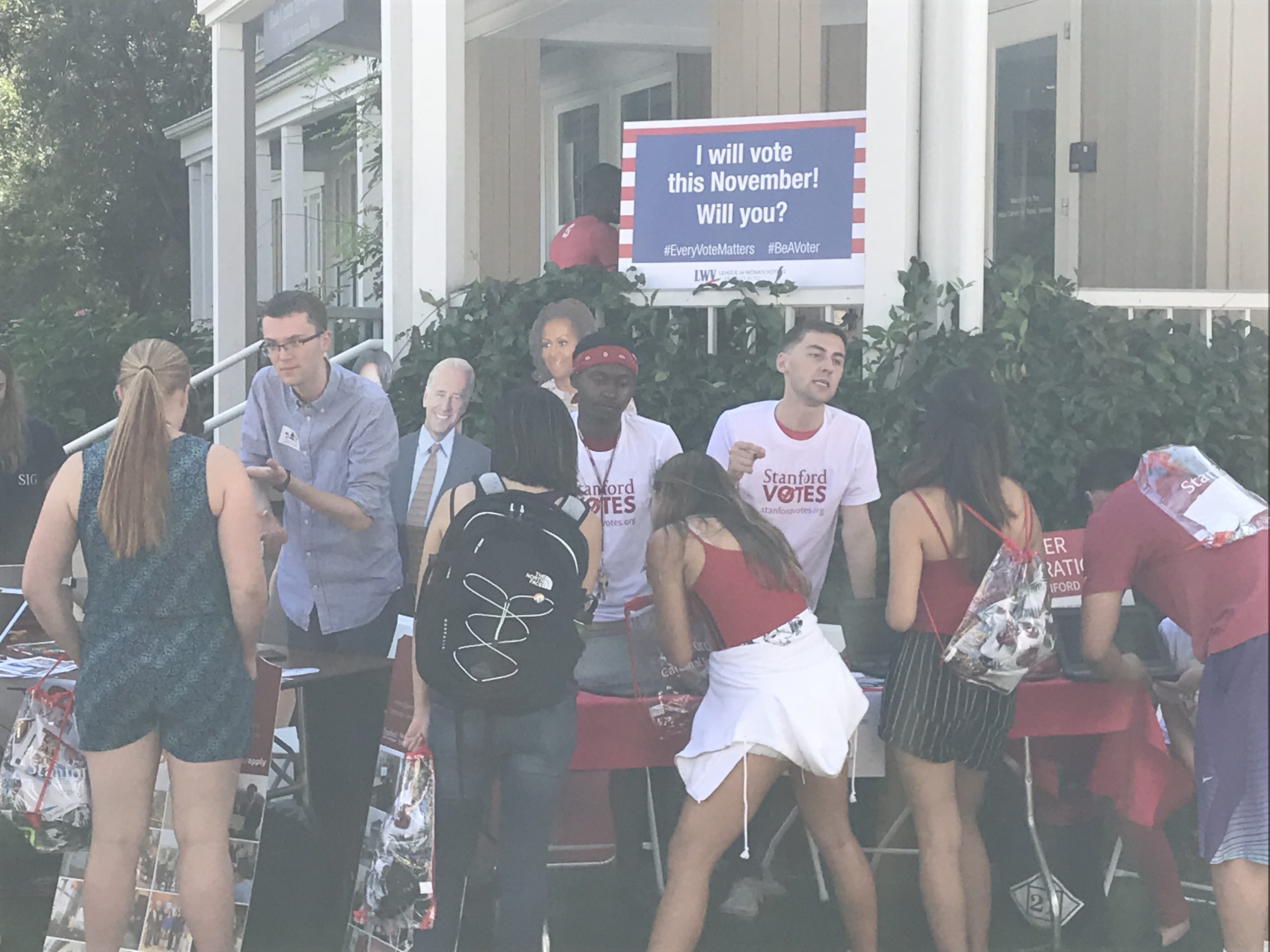During the 2018 elections, only 61% of Stanford students were registered to vote.
But before enrolling in next quarter’s classes, 100% of Stanford students will now at least have to think about it.
A new “civic engagement” enrollment hold on Axess presents students with an embedded form through which they can register to vote and requires students to check a box saying that they “acknowledge the recommendation of civic engagement” before they can enroll in classes.
The hold doesn’t require students to register to vote — and the University will not store any data on whether or not they do — but it’s part of a broader push by the organization StanfordVotes to increase participation in the 2020 elections.
“The biggest thing we wanted to do was look at [increasing voter registration] on an institutional level and look at how we can integrate voting and voter registration and voter turnout into the institution itself and use some of the levers it has to reach every student,” said Michael Swerdlow ’20, one of the leaders of the student-driven push to institute the enrollment hold.
The civic-engagement question works as part of the annual student check-in enrollment hold, a series of optional and mandatory forms that collect information required by federal law. Students access the civic engagement item through the check-in page.
An embedded form powered by the nonprofit Turbovote walks students through the process of registering to vote.
“Civic engagement is an essential feature of Stanford’s vision for its students and alumni as civic leaders,” the page states. “If you are eligible to vote in the United States, please take a few minutes to register to vote and/or request absentee ballots through TurboVote.”
To lift the hold, though, students need only to check a box below the form that states in small print: “I acknowledge the recommendation of civic engagement as stated. If able, I have made an active and informed decision about my status as a voter.”
“We don’t consider our enrollment hold to be opt-out,” said former StanfordVotes co-director Antonia Hellman ’21. “It’s purely just mandatory choice. We’re not forcing anyone to do anything — we are keeping voting in the conversation.”
Student organizers describe the campaign to institute the hold as what can happen when University administrators, campus organizations like Stanford in Government and StanfordVotes and the student government work together.
“It serves as an excellent case study for how these kinds of things can actually be implemented,” said former Undergraduate Senator Gabe Rosen ’19. “It takes a certain set of dedicated stakeholders to go out there, bill in hand … and bring that to the administration and really enter into a dialogue into them. I think that they did such an amazing job.”
The process began in the summer of 2018, when a coalition of students, faculty and staff launched an initiative, StanfordVotes, to increase voter turnout from its historically dismal levels. Fewer than one in five eligible Stanford students voted in the 2014 midterms, and less than half of eligible students cast their ballots in 2016. In 2018, 42.7% of eligible students voted.
To mobilize a sluggish campus, StanfordVotes leaders looked to peer institutions like Harvard and the University of Chicago, which had made huge turnout gains after adding voter registration forms to their mandatory student check-ins — and inspired Swerdlow and Hellman to push for an enrollment hold at Stanford.
“UChicago had an outrageous voter registration number and percentage in 2018,” Hellman said. “They were blowing everybody out of the water. They were leading by orders of magnitude.”
When Hellman and Swerdlow took their idea to the University, administrators wanted to make sure that the enrollment hold was student-driven before making it mandatory.
So Hellman and Swerdlow detoured to the Associated Students of Stanford University, co-authoring an Undergraduate Senate resolution with Rosen and Graduate Student Councillor Ana María Tárano, an aeronautics and astronautics Ph.D. candidate, in January. The Graduate Student Council passed the resolution in October.
“It sent a strong signal to the registrar’s office that the student body was serious about wanting this kind of measure,” Rosen said.
After meetings with the provost’s and registrar’s office over the summer and fall quarters to work out the details — including ensuring that the University would not have access to student data about voter registration status — the hold went into effect in time for the annual check-in.
The hold is just one part of StanfordVotes’ constellation of efforts to increase voter turnout in the lead-up to the 2020 race — an election that has already started for one group of Stanford Iowans. StanfordVotes is also planning to increase its presence at move-in next fall and has created a network of representatives who can answer questions about voting processes for each state, according to co-director Chase Small ’22.
“[Co-director Alex Chau ’22] and I have been looking at a lot of ways in how we can move from what’s been a lot of one-off tabling events in different cases to having a more institutionalized element of StanfordVotes that really has the ultimate goal of increasing civic engagement across campus,” Small said.
Contact Erin Woo at erinkwoo ‘at’ stanford.edu.
